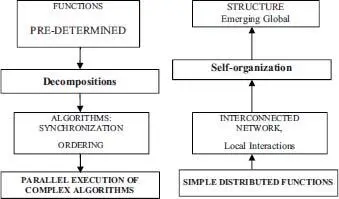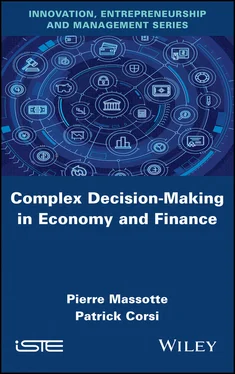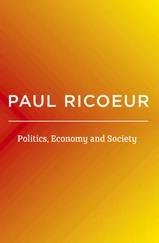– In the field of living organisms, does the gene have an influence on the intrinsic organization of organisms?
– Is the configuration of a complex system directly and strongly correlated to the emerging global property and vice versa?
However, even though obscure points remain, everyone agrees that, in the phenomena of self-organization, if complex dynamic systems and living systems allow the emergence of structural patterns or stable forms, this is the result of the same mechanisms. Thus, the evolutionary models that have been developed by scientists are important to explain how orders are developed in Nature and in our industrial systems. Such models are fundamental to understanding the meaning of an organization, how a complex system is expressed and how global orders are organized, or to simulating the impact of a structural configuration on emerging orders and properties. However, they do not in any way allow us to understand and explain the profound meaning of emerging property, the meaning of life for example, but rather to understand and demystify the theory of self-organization.
2.1.5. The genesis and evolution of complex systems
Two possibilities are considered on how order emerges, on the genesis of biological or complex forms and on the theory of order and evolution:
– Darwinism focuses on the organization of a social body, the architecture of an interconnected system, the structure of a living organism, or even the configuration of a product or process. It stipulates that any system is subject to disturbances, local disorders or random or environmentally oriented mutations (external stimuli). The reaction and adaptation of these new systems will be in a totally unpredictable direction because they are sensitive to the initial conditions (ownership of SIC). Natural selection will do the rest, and only the most appropriate configurations, forms or orders will be retained or survive;
– according to physicists, all the systems around us are subject to the second principle of thermodynamics, which stipulates that the entropy of systems increases and that they tend towards disorder. This approach does not always correspond to reality since systems with deterministic chaos are alternately subjected to phases of apparent disorder and then to order phases (quantum leaps limited to a few stable states) as the control parameter increases. Thus, in the study of complex systems, some physical theories have the greatest difficulty in being applied.
This shows us that there are several ways to understand and envisage the evolution of a complex system, but that nothing should be neglected. In fact, the notions of self-organization, selection and evolution that we have described above are complementary and conclusive and this is what we do in everyday life:
– In an industrial system, in a production plant, it is common to organize work meetings every morning to organize the team’s activities; similarly, in meetings to design and develop solutions. At some point, people exchange possibilities for changing the production program, choosing the least bad program and reconfiguring a production system to allocate resources differently, proposing “crazy ideas” about a product to meet a new demand, etc. These creative brainstorming sessions, followed by incubation periods and new brainstorming, etc., will initiate changes and elements of solutions. In short, disorder is created.
– In a second phase, the modifications and solutions implemented will lead the system to enact a particular behavior: any stimulus applied to it is translated into a specific action or reaction of the system. This will lead to the generation of a form or the convergence of the system towards a new order that we always call an attractor. This source of self-organization is almost universal and has been shown in various works by Ulam and von Neumann [NEU 63], Wolfram [WOL 02] or even in Yingjiu Liu’s thesis [LIU 02]. The system organizes itself autonomously; it is subject to a whole series of actions and interactions that are propagated in the network and, after a certain number of steps, it will gradually stabilize in a stable state.
– Finally, this situation to which we have converged will lead to a consolidation of the system’s structures, a strengthening of some of its components such as intrinsic functions at the level of agents or interactions. This phase of capitalization or adaptation will include activities such as configuration adjustment, learning, formalization of certain mechanisms, acquisition of know-how, etc. Thus, the second principle of thermodynamics is not enough if it is applied alone. Many complex systems tend towards order and not disorder. When a system is stable, an action can change it, destabilize it and turn it into disorder, but in fact such a system is placed on a new trajectory that converges towards a new order. In industry, this phase is called the structuring or self-organization phase. Thus, everything begins and ends with the organization.
The difficulty is therefore to know how an order is established in a complex structure. Everything depends of course on the behavior of nonlinear dynamic systems. Two theories are then evoked:
– Catastrophe Theory: as previously mentioned, it was developed by the French mathematician René Thom. In the 1960s, Thom showed how some nonlinear systems could “catastrophically” switch from one state to another. It is actually a jump in the trajectory. However, this very attractive approach is very limited. Indeed, in practice, the mathematical models we had developed were too “reduced” and could never be applied in practice. This is an excellent qualitative approach that allows us to imagine and describe some complex behaviors, but not to predict them. Hence, a limited industrial interest.
– Deterministic Chaos Theory: this is in fact very closely linked to and consistent with the catastrophe theory; it complements it with much greater success. Indeed, in industry, physics or biology, the description of the behavior of an elementary cell or agent can often depend on very few parameters which lead to models that are fairly close to reality, and in this case, it is possible to have a much more precise technique. This has allowed us to show, in the semiconductor manufacturing lines of the IBM Factory in Corbeil-Essonnes, how and when deterministic chaos could appear. And in the 1980s, we were able to develop innovative production management methods to better control its behavior, particularly in an area of low chaos.
2.1.6. How and where do structures emerge?
Complexity theory has a certain universality in that, in Nature, we are surrounded by complex systems with nonlinear functions and interactions. Such systems have the property of evolving in a divergent way, but in a limited space. For example, the number of states that a chaotic system can achieve may or may not be limited, but the extreme values are in a limited space. Similarly, a fractal structure has a dimension represented by a real number, but this is within certain limits. For example, a quasi-volume has a real dimension between integers 2 and 3.
In all complex systems, there is a powerful intrinsic dynamic. The objective is to migrate a system to the border of chaos to turn it upside down and acquire new properties, which we have also called orders. Indeed, these systems evolve according to an internal dynamic in an unpredictable way (because they cannot be calculated) and converge towards an emerging global structure. These considerations therefore lead us to define the following schema of principle in which two totally different approaches to complex system management are included.

Читать дальше













